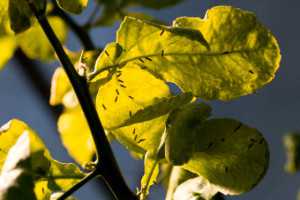First Case of Deadly Citrus Disease Confirmed in Alabama
A scourge that has ravaged Florida’s citrus industry for more than a decade appears to have finally found its way to Alabama as federal and state plant health officials have confirmed the identification of citrus greening (aka, HLB) in leaf and insect samples from a residential property on Dauphin Island in Mobile County.

Photo by Tyler Jones, UF/IFAS
This is the first confirmation of HLB in Alabama despite biannual surveys for the pathogen by the Alabama Department of Agriculture and Industries (ADAI). The ADAI, along with the USDA Animal Plant Health Inspection Service and the U.S. Department of Homeland Security Customs and Border Protection, will be conducting a delimiting survey to determine the extent that the pathogen may have spread.
ADAI surveillance teams will take additional samples for testing, survey the area around the site and gather data on the tree’s history, if possible. In addition, outreach and education to nurseries, plant dealers, and citrus hobbyists will be conducted.
Officials have begun the process to halt the movement of citrus plants from the area. With the confirmation of citrus greening in Dauphin Island, federal plant officials will seek to establish a citrus greening quarantine in Mobile County. Alabama agriculture officials have indicated that the state intends to take action to establish a parallel quarantine.
The Asian citrus psyllid (ACP) — HLB’s vector — was found in Baldwin County, AL, in 2008, but no citrus greening bacteria was detected, even though molecular analysis of insects collected in the area was conducted. The discovery of psyllids in 2008 led to federal and state ACP quarantines of the entire State of Alabama in 2009.









